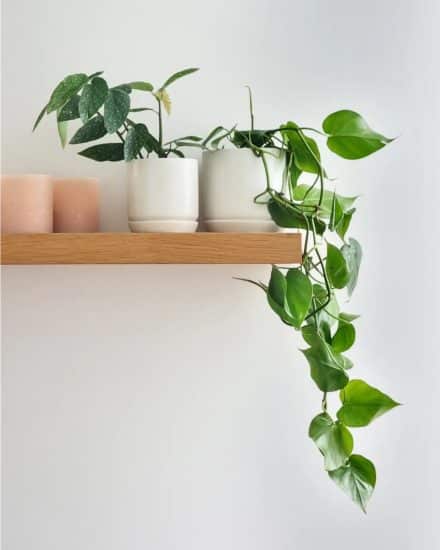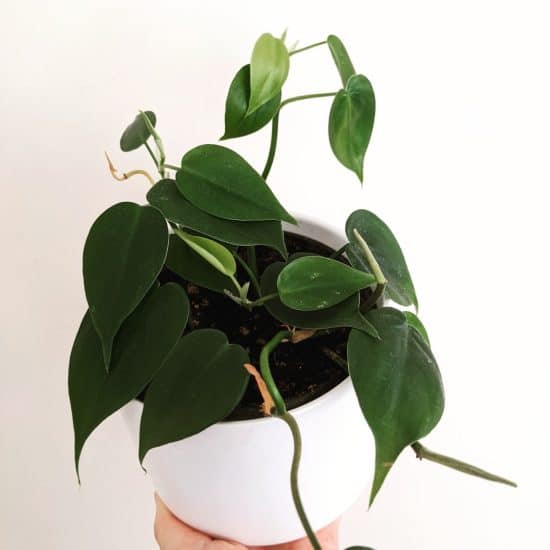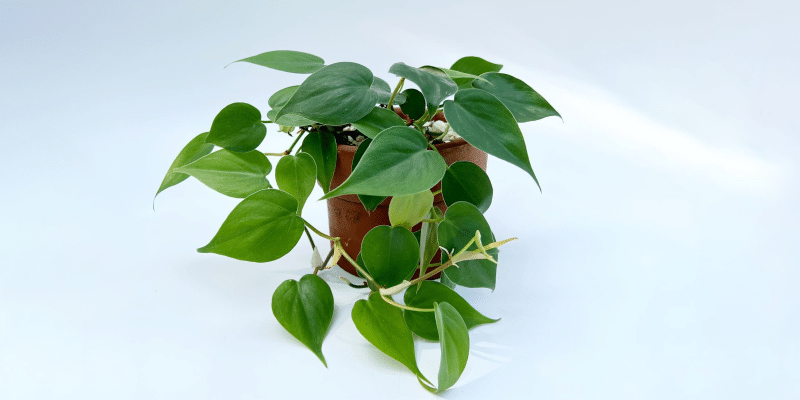Heartleaf philodendron are easy to care for, and happy to be trained up a moss pole, sit in a hanging basket, or grown in a regular pot.
If you’ve spent any time looking at interior design (guilty as charged), you’ll see these heart-shaped leaves all over the place, being carefully vined throughout a room to add a beautiful living accent.
In our guide, we’re going to cover how to take care of your Heartleaf philodendron plant, the most common issues that come up, and our favorite method of propagation.
Table of Contents
Heartleaf philodendron Care Guide
History, habitat, and characteristics

Heartleaf Philodendron (Philodendron hederaceum), also known as the sweetheart plant, is beloved for its ease of care, beautiful heart-shaped leaves, and adaptability, as it is equally at home on the floor or in a hanging basket as a vining plant.
(This plant has different names in different parts of the world, so you might also see it called Philodendron scandens.)
A climbing plant that originates from Central America, Heartleaf philodendron starts its life on the floor of the rainforest and uses other plants and trees to reach the light in the canopy. You can train this plant and have it grow faster when it’s able to climb. You can also place it in a hanging planter if you don’t mind slower growth.
Aerial roots are standard, but this Philodendron isn’t a true epiphyte and just uses other plants as structures to reach out to better light. Like most Philodendrons in nature, it starts at the bottom of the forest and works its way up.
As its name suggests, its leaves are in the shape of hearts in a range of beautiful, lush greens. These leaves do grow quite a bit larger at the plant matures, but rarely larger than the size of a hand.
Naming can be a bit difficult with Philodendron plants. You’ll see two primary varieties of Heartleaf Philodendron available: Philodendron ‘oxycardium’ (a.k.a., Brasil) with green, yellow, and red-hued leaves, and Philodendron ‘scandens’, which is vining and great in a hanging basket.
Heartleaf philodendron is versatile as an indoor plant: it’s happy both hanging with vines that reach out for the sun (or other plants!), or in a pot and pruned back.
(We’ll teach you how to propagate those cuttings later.)
Our Heartleaf philodendron guide is broken up into different sections of care, so you can click that table of contents above and navigate either to the care of the plant you’re curious about, how to propagate, or read about the common issues that come up.
Light

Heartleaf philodendron plants are popular houseplants because they really thrive in a lot of lighting conditions. For optimal growth, you should place your philodendron away from direct sunlight, in a bright area with plenty of indirect light.
So how do you know if your Heartleaf philodendron is getting enough light?
We’ll want to look at the leaves. They should look vibrant, with deep green throughout.
While Heartleaf philodendron want a lot of light, they don’t like direct sunlight. You’ll want to avoid south-facing windows which have lots of direct light that comes at the hottest part of the day.
Too much of this direct light will result in leaves that look sun-bleached, and burnt, with brown edges and tips. Ever see an old restaurant menu in the window that’s been faded by UV over many years? Your leaves will sort of… take on that appearance. You don’t want old-restaurant-menu leaves.
That being said, your heart-leaf philodendron probably will survive even in direct sunlight, showing you larger leaves and faster growth. You’ll notice most of the burnt leaves will be turned toward that window, and any facing away should look just fine. This is a good way to tell that those issues are caused by too much light.
Brighter light also means shorter internodes along the stems. Internodes are the distance between each leaf node on stems. With brighter light, it’ll be able to create more leaves, closer together. If you want a dense, bushy look, you need to keep your plant in bright light.
If you want a leggier, vining look, you need to actually keep the light a bit lower.
Water

Heartleaf philodendron doesn’t like to dry out too much. It really wants a little bit of moisture all the time, which can be tricky to get just right without damaging the roots.
We’ll cover the soil to use in a little bit, so let’s first talk about how to know when to water.
Take a finger and feel the soil, going down about 2 inches. if it’s dry throughout, give it some water. Just make sure it’s room temperature, because cold water can shock the plant and even prevent new growth.
Your sweetheart plant will need more water in the growing season, or really whenever you see a lot of growth. Plant stomata (basically plant pores) will be open in the winter, so they won’t suffer too much from overwatering, but it can still stress the plant out.
Standing water should be avoided. You’ll notice leaves turning yellow almost overnight, and probably see 2-3 turn all at once.
Not enough water is pretty easy to detect: the soil will be dry and the leaves will look withered, hanging down.
Watering is also a good time to wipe down leaves gently with a damp cloth, keeping those stomata functional and not clogged with dust.
Temperature and humidity
To keep your heartleaf philodendron plant happy, there are two key elements you need to get right – temperature and humidity.
For temperature: whatever you’re comfortable with in your house should be just fine. Just be careful of the radiator in the winter, because this warm heat can dry out the plant, so you might have to adjust its placement slightly in the cooler months.
This plant also doesn’t like drafts at all, so if you have it placed near a fireplace or drafty window, just keep an eye on the overnight temperatures. Same with bringing it home from the store — you’ll want to make sure you don’t shock this plant if you’re buying it in the winter.
Heartleaf philodendron can withstand most humidity levels. Since they go dormant in the winter, you’ll notice them drooping a bit. This is nothing to worry about, but because those stomata are open, just make sure to keep the humidity high, especially because furnaces can dry out the air.
To keep your humidity levels high:
- Set up a pebble tray (fill a shallow container with rocks and water) underneath or next to your plants to raise humidity by 5-7%
- Group plants with similar humidity needs together — this raises the local levels through transpiration
Low humidity levels will cause slower growth (fewer new leaves), and you’ll notice stem nodes won’t sprout new stems.
Soil and planting

Heartleaf philodendron really doesn’t like to stand in water and does have difficulty if placed in a container much too large.
Why is that?
Healthy root systems naturally drink water from the soil, moving it through the plant and then out through the leaves. When there’s too much volume in a container, the moist soil provides more water to the plant than it’s able to pull out. That means the soil will stay wet for a lot longer, leading to pests and fungus issues.
Solution?
Go up no more than one or two sizes when repotting. This pot should also have drainage holes in the bottom, and then you can place it in another outer pot for decoration.
For your potting soil mix, anything you can find at the store should be just fine. Avoid soil with time-release fertilizer added. You’ll also want to add a bit of perlite to increase aeration drainage. We really want excess water to find its way out, so we’ll help it.
Fertilizer can be used in the spring and early summer. Just use it a few times a year, or if you want to fertilize more frequently, cut it to 20-40% dilution.
Pruning
These indoor plants are easy to prune, and you can prune during every season but winter. You’ll see new shoots from where you cut.
This plant stores a hormone in the ends of its stems called auxin, which is responsible for controlling if the plant wants to grow longer or sprout from its existing nodes. When you cut the plant, you’ll reduce the amount of this hormone, and soon you’ll see growth from other previously dormant nodes lower down on the plant.
New shoots will look a lot thicker if they’re getting lots of light, humidity, and fertilizer. So keep an eye on new stem growth for an indication of how well your care is calibrated.
Propagation guide

Propagating Heartleaf philodendron is a lot of fun. You can take the same stem cuttings you prune and use them to grow new plants. You can replant these later in the same pot, create a new trailing or climbing plant, or just hand out a baby heart-leaf to a friend.
To propagate your Heartleaf philodendron plant:
We’re going to use stem cuttings in water. You’ll need: a clean knife or pair of scissors, a jar or cup of filtered water, and the heart-leaf you want to propagate.
- Cut a 5-6 inch long stem with at least a few nodes on it. A leaf node is a little bump on the stem where new stems and leaves will grow. You want a long enough segment so that after you remove the lower stems, you have an exposed node where its root system can grow from.
- Trim back a few inches so that one of these nodes is near the bottom of the stem, leaving a few healthy leaves on top.
- Place your heart-leaf cutting in a jar of water, nodes submerged and leaves above the water.
- Change the water out every few days, and keep it in bright light and high humidity for a few weeks. You’ll notice roots begin to grow, and once they reach 2 inches, you can replant in soil. Water that soil thoroughly.
Common issues

Taking care of your Heartleaf Philodendron is like tuning the strings on a guitar – if the adjustments are just right, beautiful music can be made. If things are a little bit off… it can feel discordant.
So what are the signs that your tropical plant has gone out of tune?
Wilting leaves or leaves suddenly dropping
Often a sign of not enough water in Heartleaf philodendron. You’ll want to check to see if it’s affecting all the leaves and if there’s any additional discoloration. If it’s just the mature leaves closer to the base of the plant, this can be completely normal, especially in the winter.
If all leaves are suddenly affected, pay attention to temperature, because this is often a sign of a cold shock. These tropical plants can put up with some temperature fluctuation, but they’re a bit cold-sensitive.
Also, check the soil to make sure it’s damp but not soggy. Really a good thing to do with any of these issues!
Yellowing leaves
If all of your leaves are suddenly turning yellow, this can be an issue with water quality or over-fertilization. Also expect to see brown tips. You’ll want to switch to filtered water if possible, and if you did just fertilize, flush the soil out with water to leach out any excessive nutrients.
If only a few leaves are affected, this is likely a pest issue, which we’ll cover in the next section.
Diseases and pests
Heartleaf philodendron is a pretty robust plant, but if weakened, can succumb to a lot of the most common pests and diseases. We’ll cover the three we see the most.
Spider mites
Hard to see, we often notice their webs first on the back of leaves. If it’s another kind of mite, you may not notice them until it’s really thousands upon thousands of them clustering together. So how can you tell if something is wrong?
You’ll notice leaves turning yellow… but not all the way around and not all of them, just a few. This is a good sign that it’s either direct sun or pests. Mites also tend to attack the youngest leaves first, because this is where nutrients from the plant are flowing through thinner cell membranes.
The fix is to spray it down with water, ideally outside using a strong pressure. Add neem oil applications, a few weeks apart, so that you can completely disrupt the lifecycle of the mites, along with their eggs.
Mealybugs
Mealybugs are the other pest we see the most on Philodendron hederaceum. They love to eat the plant’s sap, so you might notice it accumulating on the surface of leaves. These guys are a fair bit larger, so we can just remove them and wipe them away with alcohol or soapy water. Neem oil, again, works great and kills off any eggs.
Root rot
As we mentioned before, Heartleaf philodendron do like moist soil, which can give us an issue that other plants don’t have as often. The fungi that cause root rot are always in the soil, but they’re activated by water and seem to thrive in compacted soil that has less air.
We can avoid this by keeping our soil well-aerated. But if you do notice a mushy root system that is slimy and a bit brown, you’ll need to cut the affected roots away and switch out the soil completely. This could be a good time to add more perlite or LECA to ensure your soil has plenty of air and roots have room to grow.
Root rot will often cause yellowing leaves and even mushy stems, so this combined with wet soil should encourage you to investigate further.
Conclusion

Heart-leaf philodendron hederaceum is an easy-to-care-for indoor plant with beautiful heart-shaped leaves. If you’re looking to really nail a certain indoor style, or you’re a beginner looking for a first plant, this is a fantastic choice that won’t stress you out too much or limit you to a single look.
Heartleaf philodendron care tips:
- Heartleaf philodendron grow faster in lots of indirect sunlight or when trained to climb up a peat moss pole.
- Leggy stems are a sure sign of low light conditions, so increase light or embrace the legginess.
- Really feel the soil surface before watering. You don’t want to let the potting soil dry out completely, but if it does, this is a good sign that it’s time for more water.
That’s it for our Heartleaf philodendron guide! If you have any questions or want to send in a picture of some beautiful variegated leaves… we won’t say no.
Take care!
FAQ
What is the difference between Philodendron hederaceum and Philodendron scandens?
These are actually both the same plants. For a variety of reasons, the Philodendron genus has a lot of regional naming conventions, probably because they’re such popular plants throughout the world.
Which heartleaf philodendron fertilizer should I use?
We recommend any balanced liquid fertilizer. By default, you should use it every few months from spring through fall and at 50% dilution.
Can you bring this plant outdoors?
You can! Just make sure it doesn’t attract too many pests when bringing it back inside, and that its aerial roots don’t attach too tightly to a deck or other structures, or you’ll have some unwinding to do.
Are Heartleaf philodendron hanging plants?
Heartleaf philodendron are hemiepiphytes, so they love to climb or hang, but don’t require other plants to survive. You can also train heart-leaf philodendron to grow along a moss pole or another staked structure, like wire.
Are Philodendron hederaceum safe for pets?
Heartleaf philodendron do contain calcium oxalate crystals, which are irritants and dangerous for pets and kids, so make sure to keep these house plants out of their reach.
What is the ideal potting mix for a Heartleaf philodendron plant?
Any potting soil mix you find at the store should be fine, but we recommend avoiding one with timed-release fertilizer in it. You’ll also want to consider adding perlite or another aerating material to let the soil dry out between watering.
Are Heartleaf philodendron plants considered tropical plants?
They are! Heartleaf philodendron’s native habitat is in the Caribbean, and they love the same conditions when possible in the home. This means lots of warm temperatures and indirect light, as if it was naturally filtered through the canopy of leaves and trees above it.
Your potting medium should reflect this as well, so you’ll want soil that drains quickly.


